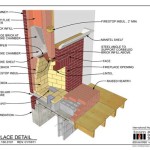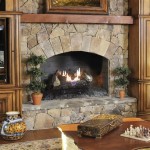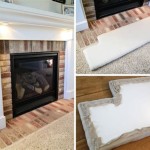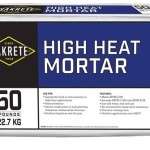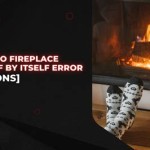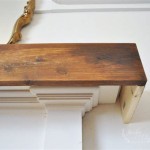Understanding Inside Gas Fireplace Paint: Selection, Application, and Durability
Gas fireplaces offer a convenient and efficient way to introduce supplemental heating and ambiance into a home. While often perceived as low-maintenance compared to traditional wood-burning fireplaces, they still require periodic attention to maintain their aesthetic appeal and optimal performance. One critical aspect of this maintenance involves the interior surfaces of the firebox, which can become discolored or damaged over time due to heat exposure and combustion byproducts. This is where the selection and application of appropriate inside gas fireplace paint become essential.
The interior of a gas fireplace experiences extreme temperature fluctuations. Standard paints are simply not formulated to withstand these conditions and will quickly fail, leading to peeling, bubbling, and the release of potentially harmful fumes. Therefore, specialized high-temperature paints are necessary for effectively refinishing the firebox. This article will delve into the specific characteristics, selection criteria, application techniques, and durability considerations associated with paints designed for the interior of gas fireplaces.
Key Point 1: Identifying the Need for Refreshing Gas Fireplace Interior Paint
Several factors can indicate that the interior of a gas fireplace requires repainting. The most obvious sign is visible deterioration of the existing paint. This can manifest as flaking, peeling, blistering, or discoloration of the surface. These issues not only detract from the fireplace's aesthetic appeal but can also indicate a compromise in the protective layer meant to withstand high temperatures.
Another indicator is the presence of rust or corrosion on the metal surfaces within the firebox. While gas fireplaces produce less ash and creosote compared to wood-burning fireplaces, moisture condensation and residual combustion byproducts can still contribute to corrosion over time. If rust is present, it needs to be thoroughly addressed before applying new paint to ensure proper adhesion and prevent further deterioration. Preparing rusted surfaces typically involves removing the rust, cleaning the metal, and applying a rust-inhibiting primer before painting.
Furthermore, even if the existing paint appears intact, fading or a dull appearance can warrant a refresh. Over time, the intense heat can cause the paint's pigments to break down, leading to a less vibrant or less appealing look. Applying a fresh coat of paint can restore the firebox's original appearance and enhance the overall ambiance of the fireplace.
Finally, any repair work performed on the interior of the fireplace, such as replacing burner components or repairing damaged firebricks, may require touching up or completely repainting the affected areas to ensure a uniform and aesthetically pleasing finish.
Key Point 2: Selecting the Right High-Temperature Paint for Gas Fireplaces
Selecting the correct type of paint is crucial for the longevity and performance of the refinished gas fireplace interior. Standard paints are unsuitable due to their inability to withstand high temperatures without degrading. Only paints explicitly formulated for high-temperature applications should be considered.
These specialized paints typically fall into two main categories: aerosol spray paints and liquid paints applied with a brush or roller. Aerosol spray paints are generally more convenient for smaller areas and intricate designs, while liquid paints may be preferable for larger surfaces or when a thicker coating is desired. Regardless of the application method, the paint must be specifically labeled as high-temperature paint and rated for the maximum temperature expected within the firebox.
Two common types of high-temperature paints are silicone-based and ceramic-based paints. Silicone-based paints provide good heat resistance and flexibility, making them suitable for surfaces that may expand and contract with temperature changes. Ceramic-based paints offer even higher heat resistance and a more durable, scratch-resistant finish. The choice depends on the specific temperature requirements, aesthetic preferences, and the material of the firebox interior.
When selecting paint, it is crucial to check the manufacturer's specifications regarding heat resistance, surface preparation requirements, drying time, and recommended application techniques. Some paints may require a primer, while others can be applied directly to properly prepared surfaces. It is also important to consider the desired finish, such as matte, satin, or gloss, as well as the available color options. Black is a common choice for gas fireplace interiors, as it effectively absorbs light and enhances the appearance of the flames. However, other colors, such as metallic or textured finishes, may be available to suit different aesthetic preferences.
It is also advisable to choose a paint that is specifically designed for use on metal surfaces. Some high-temperature paints are formulated for specific materials, such as cast iron or steel. Selecting a paint that is compatible with the firebox material will ensure optimal adhesion and prevent premature failure.
Key Point 3: Proper Application Techniques for Long-Lasting Results
Even the highest quality high-temperature paint will not perform optimally if not applied correctly. Proper surface preparation is paramount to achieving a durable and long-lasting finish. This typically involves cleaning the surface thoroughly to remove any dirt, grease, rust, or loose paint. A wire brush or sandpaper can be used to remove rust and loose paint, followed by cleaning with a degreasing agent to remove any oil or residue.
If rust is present, it is crucial to treat it with a rust converter or inhibitor before applying the paint. This will prevent the rust from spreading underneath the new paint layer and compromising its adhesion. After cleaning, the surface should be rinsed thoroughly with water and allowed to dry completely.
Masking off areas that are not to be painted is essential to prevent overspray or unwanted paint on surrounding surfaces. This can be done using painter's tape and drop cloths. Ensure that the masking is secure and covers all areas that need protection.
When applying aerosol spray paint, hold the can approximately 8-12 inches from the surface and apply thin, even coats. Avoid applying too much paint in one coat, as this can lead to runs and drips. Allow each coat to dry completely before applying the next. Multiple thin coats are preferable to one thick coat, as they will cure more evenly and provide a more durable finish.
When applying liquid paint with a brush or roller, use a high-quality brush or roller specifically designed for paint application. Apply the paint in smooth, even strokes, overlapping each stroke slightly to ensure complete coverage. Avoid applying excessive pressure, as this can lead to brush marks or roller stipple. As with aerosol spray paint, multiple thin coats are preferable to one thick coat. Allow each coat to dry completely before applying the next.
After applying the final coat of paint, allow it to dry completely according to the manufacturer's instructions. The drying time may vary depending on the type of paint, ambient temperature, and humidity. Do not use the fireplace until the paint is fully cured, as this can damage the finish and release potentially harmful fumes.
Proper ventilation is crucial during the application and drying process. Open windows and doors to allow for adequate airflow. Wear a respirator or mask to avoid inhaling paint fumes. Follow all safety precautions listed on the paint can or product label.
Finally, regular maintenance can extend the life of the paint job. Periodically inspect the painted surfaces for any signs of damage, such as scratches, chips, or discoloration. Touch up any damaged areas promptly to prevent further deterioration. Keep the interior of the fireplace clean by removing any debris or soot that accumulates over time. This will help to maintain the appearance of the paint and prevent it from becoming stained or discolored.
By carefully selecting the appropriate high-temperature paint and following proper application techniques, homeowners can effectively restore and maintain the aesthetic appeal of their gas fireplace interiors, ensuring years of enjoyable use.

How To Paint The Inside Of A Fireplace Simple Upgrade Maria Louise Design

Fireplace Makeover Spray Paint Magic

How To Spray Paint Fireplace Interior The Diy Playbook

Paint Inside Of Your Fireplace South House Designs

How To Paint A Fireplace Box

Fireplace Makeover Spray Paint Magic

Painting The Interior Of A Fireplace Shine Your Light

Diy Fireplace Makeover With High Heat Paint Jessica Welling Interiors

What Kind Of Paint To Use On The Inside A Fireplace Hunker

How To Paint A Brick Fireplace Beamin Moore
Related Posts

